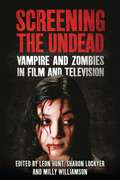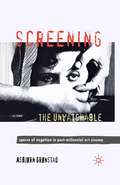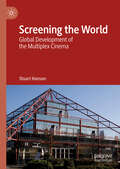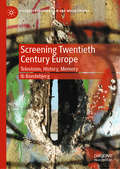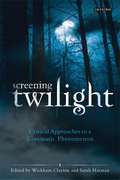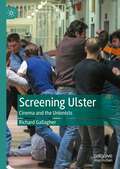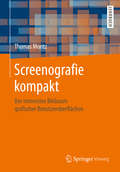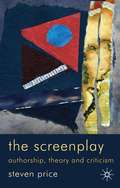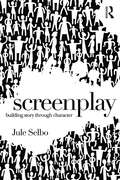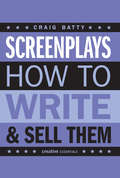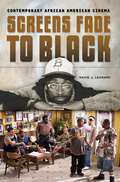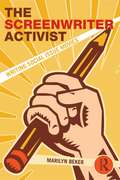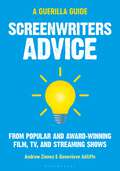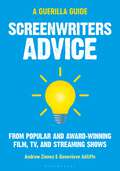- Table View
- List View
Screening the Undead: Vampires and Zombies in Film and Television
by Leon Hunt Sharon Lockyer Milly WilliamsonThe vampire and the zombie, the two most popular incarnations of the undead, are brought together for a forensic critical investigation in Screening the Undead. Both have a long history in popular fiction, film, television, comics and games; the vampire also remains central to popular culture today, from literary 'paranormal romance' to cult TV and movie franchises - by turns romantic, tortured, grotesque, countercultural, a goth icon or lonely outsider. The zombie can shamble or, nowadays, sprint with alarming velocity, and even dance. It frequently lends itself to metaphor and can stand in for fascism or ecological disaster, but is perhaps most frequently a harbinger and instrument of the apocalypse.Leading writers on Horror and cult media consider the sexy vampire and the grotesque zombie, as well as hybrid figures who do not fit neatly into either category. These are examined across a range of contexts, from the Swedish vampire to the Afro-American Blacula, from the lesbian vampire to the gay zombie, from the Spanish Knights Templar riding skeletal horses to dancing Japanese zombies. Screening the Undead sheds new light on these two icons of terror - and desire - whose popular longevity has taken them 'Beyond Life'.
Screening the Unwatchable: Spaces of Negation in Post-Millennial Art Cinema
by A. GrønstadTracing the rise of extreme art cinema across films from Lars von Trier's The Idiots to Michael Haneke's Caché, Asbjørn Grønstad revives the debate about the role of negation and aesthetics, and reframes the concept of spectatorship in ethical terms.
Screening the World: Global Development of the Multiplex Cinema
by Stuart HansonThis book charts the development of the multiplex cinema as the pre-eminent form of film exhibition across the world. Going from its origins in the USA in the 1960s to its expansion overseas from the mid-1980s across Europe, Australia and other parts of Asia-Pacific, the book considers the emergence of a series of initially regional, then national and then international exhibition circuits. However, more than a consideration of US overseas expansion on the part of companies, this book examines the hegemony of the multiplex as a cultural and business form, arguing for its significance as a phenomenon that has transcended national and global boundaries and which has become the predominant venue for film viewing. Implicit in this analysis is a recognition of the domination of US media multi-nationals and Hollywood cinema, and the development of the multiplex cinema as symbolic of the extension and maintenance of the USA’s cultural and economic power. With case studies ranging from European countries such as Belgium, France, Germany and The Netherlands, to Pacific-Asian countries such as Australia, China, Japan and South Korea, this book is the first to explore the development of multiplexes on a global scale.
Screening Twentieth Century Europe: Television, History, Memory (Palgrave European Film and Media Studies)
by Ib BondebjergThis book offers a comparative study of historical television genres in Europe, with a special focus on Germany and Great Britain and their way of narrating twentieth century European history. The book analyses our common European past and memory through central historical television narratives. Each chapter looks at how historical TV genres, fictional and documentary, have dealt with the most salient and defining periods, events and changes in the twentieth century— an age of extremes. Bondebjerg offers unique theoretical and analytical insight into the role of television in mediating and shaping the past. The book explores television’s creation of transnational cultural encounters across Europe in relation to our common and national past. The book addresses how television has influenced our understanding of history, collective memory and public debate over the twentieth century. It is fundamentally a book about the importance of the past in present day Europe and the centrality of media for transnational understanding.
Screening Twilight: Critical Approaches to a Cinematic Phenomenon (International Library Of The Moving Image Ser.)
by Sarah Harman Wickham ClaytonThe Twilight Saga, a series of five films adapted from Stephanie Meyer's four novels, has been a sensation, both at the box office and through the attention it has won from its predominantly teenaged fans. As popular cinema, the series has had its share of criticism, even from fans. However, it also offers rich opportunities for critical attention, which the contributors to Screening Twilight provide with energy and style.The book unpacks how this popular group of films work as cinematic texts, what they have to say about cinema and culture today, and how fans may seek to re-read or subvert these messages. Chapters address Twilight in the context of the vampire and myth, in terms of genre and reception, identity, gender and sexuality, and through re-viewing the series fandom. Screening Twilight is a revelation of how a popular cinematic phenomenon can reward close attention from scholarly, critical writers on cinema and culture.
Screening Ulster: Cinema and the Unionists
by Richard GallagherThis book presents extensive research into the cinematic representation of the British-identifying Protestant, unionist and loyalist community in Northern Ireland and is the first time such comprehensive analysis has been produced. Gallagher’s research traces the history of the community’s representation in cinema from the emergence of depictions of both nationalist and unionist communities in social-realist dramas in 1980s British and Irish cinema to today, through periods such as those focused on violent paramilitaries in the 1990s and irreverent comedy after the Northern Ireland peace process. The book addresses the perception that the Irish nationalist community has been depicted more frequently and favourably than unionism in films about the period of conflict known as “The Troubles”. Often argued to be the result of an Irish nationalist bias within Hollywood, Gallagher argues that there are other inherent and systemic reasons for this cinematic deficit.
Screenografie kompakt: Der immersive Bildraum grafischer Benutzeroberflächen
by Thomas MoritzDieses Buch behandelt die Screenografie von grafischen Benutzeroberflächen basierend auf einem didaktisch strukturierten Lehrprogramm, dessen Kapitel inhaltlich aufeinander aufbauen und jeweils in einem zusammenfassenden Fazit enden. Nach einer einführenden thematischen Motivation werden wahrnehmungspsychologische und kommunikationswissenschaftliche Grundlagen des Systemischen Designs erläutert, dessen Spezifik für die systematische Entwicklung grafischer Benutzeroberflächen essentiell ist. Im Kontext immersiver Raumnutzung wird u.a. illustriert, wie ein Screen morphologisch in kleinere geometrische Einheiten unterteilbar ist, die als visuelles Ganzes die ideale Basis für ein visuelles Gestaltungsraster bilden, welches den immersiven Bildraum strukturiert und organisiert. Es werden nutzerspezifische Farbgebungen für ein visuelles Ambiente aufgezeigt, das einem speziellen Nutzernaturell entspricht, da es auf Erfahrungen mit natürlichen Umgebungen basiert und über alle geografischen und ethnologischen Grenzen hinweg stimuliert und zur interaktiven Nutzung motiviert.
Screenografie kompakt: Der immersive Bildraum grafischer Benutzeroberflächen
by Thomas MoritzDieses Lehrprogramm zur systematischen Gestaltung eines interaktiv nutzbaren Bildschirms (Screen) erläutert wahrnehmungspsychologische und kommunikationswissenschaftliche Grundlagen, die für das Systemische Design grafischer Benutzeroberflächen (Graphical User Interfaces) relevant sind. Im Kontext interaktiver Raumnutzung wird illustriert, wie die Bildschirmfläche morphologisch in Form eines visuellen Gestaltungsrasters (Visual Design Pattern) zu gliedern ist, das den immersiven Bildraum der grafischen Benutzeroberfläche strukturiert und die interaktive Nutzung erleichtert. Es werden mögliche Farbkombinationen für ein visuelles Ambiente definiert, deren Wirkungsweise auf natürlichen Erfahrungswerten basiert und somit einem speziellen Nutzernaturell entspricht, dessen Charakteristika weltweit identisch sind.
The Screenplay: Authorship, Theory and Criticism (PDF)
by Steven PriceAfter decades of neglect, the screenplay is finally being recognized as a form that deserves serious critical analysis. This book for the first time combines detailed study of the theory and practice of screenwriting with new approaches to criticism and original studies of individual texts.
Screenplay: Building Story Through Character
by Jule SelboScreenplay: Building Story Through Character is designed to help screenwriters turn simple or intricate ideas into exciting, multidimensional film narratives with fully-realized characters. Based on Jule Selbo’s unique 11-step structure for building story through characters, the book teaches budding screenwriters the skills to focus and shape their ideas, turning them into stories filled with character development, strong plot elements based on obstacles and conflicts, and multifaceted emotional arcs. Using examples and analysis from classic and contemporary films across a range of genres, from The Godfather to Guardians of the Galaxy, Selbo’s Screenplay takes students inside the scriptwriting process, providing a broad overview for both beginners and seasoned writers alike. The book is rounded out with discussion questions, writing exercises, a guide to the business of screenwriting, in-depth film breakdowns, and a glossary of screenwriting terms.
Screenplay: Building Story Through Character
by Jule SelboScreenplay: Building Story Through Character is designed to help screenwriters turn simple or intricate ideas into exciting, multidimensional film narratives with fully-realized characters. Based on Jule Selbo’s unique 11-step structure for building story through characters, the book teaches budding screenwriters the skills to focus and shape their ideas, turning them into stories filled with character development, strong plot elements based on obstacles and conflicts, and multifaceted emotional arcs. Using examples and analysis from classic and contemporary films across a range of genres, from The Godfather to Guardians of the Galaxy, Selbo’s Screenplay takes students inside the scriptwriting process, providing a broad overview for both beginners and seasoned writers alike. The book is rounded out with discussion questions, writing exercises, a guide to the business of screenwriting, in-depth film breakdowns, and a glossary of screenwriting terms.
Screenplays & how to write & sell them: How To Write And Sell Them (Writing And Selling Screenplays Ser.)
by Craig BattyScreenplays … How to Write and Market Them is an accessible yet comprehensive book aimed at those with a keen interest in writing feature film screenplays. Using case studies, creative exercises and interviews from the industry, the book will guide readers through the necessary stages of writing a screenplay, from finding and developing ideas to creating and executing characters to shaping structure and constructing scenes. It will also consider how a screenplay might be sold, or used to raise interest in the writer, looking at areas such as finding and working with an agent, networking, using competitions, and raising private production funds. The book's approach is both creative and reflective, giving readers the opportunity to learn a wealth of creative skills alongside skills that will encourage them to think about themselves as writers and the work that they are developing. As such, the book will empower readers in their own creative processes and allow them to successfully tell the stories they want to tell. Rich with analyses from classic and contemporary films, littered with practical models, paradigms and creative tasks, and enhanced by the views of key industry figures, the book is a must for any aspiring feature film screenwriter.
Screens Fade to Black: Contemporary African American Cinema
by David J. LeonardThe triple crown of Oscars awarded to Denzel Washington, Halle Berry, and Sidney Poitier on a single evening in 2002 seemed to mark a turning point for African Americans in cinema. Certainly it was hyped as such by the media, eager to overlook the nuances of this sudden embrace. In this new study, author David Leonard uses this event as a jumping-off point from which to discuss the current state of African-American cinema and the various genres that currently compose it. Looking at such recent films as Love and Basketball, Antwone Fisher, Training Day, and the two Barbershop films—all of which were directed by black artists, and most of which starred and were written by blacks as well—Leonard examines the issues of representation and opportunity in contemporary cinema.In many cases, these films-which walk a line between confronting racial stereotypes and trafficking in them-made a great deal of money while hardly playing to white audiences at all. By examining the ways in which they address the American Dream, racial progress, racial difference, blackness, whiteness, class, capitalism and a host of other issues, Leonard shows that while certainly there are differences between the grotesque images of years past and those that define today's era, the consistency of images across genre and time reflects the lasting power of racism, as well as the black community's response to it.
Screens Producing & Media Operations: Advanced Practice for Media Server and Video Content Preparation
by Laura FrankMedia servers have established themselves as the dominant video playback tool for live events; however, the practice of delivering content to these systems and the structure of the media operations team is still evolving. This book outlines a workflow for video content delivery and describes team communication that can be applied to any entertainment production including: television specials, concert touring, corporate events, theater, as well as special events, film, large audience marketing events, and multi-screen permanent installations. This workflow is hardware and software independent, designed to evolve with future technologies as they become established in the field of multi-screen production, and has been proven professionally by the author and her peers over a decade of productions. The methodology presented will provide insights beneficial to students and current practitioners of media server technology, screens producers, and video content developers. Using real world examples of internationally recognized productions, a foundation is laid for best practices in Media Operations. Additional content, including full-color versions of the images inside the book, is available online.
Screens Producing & Media Operations: Advanced Practice for Media Server and Video Content Preparation
by Laura FrankMedia servers have established themselves as the dominant video playback tool for live events; however, the practice of delivering content to these systems and the structure of the media operations team is still evolving. This book outlines a workflow for video content delivery and describes team communication that can be applied to any entertainment production including: television specials, concert touring, corporate events, theater, as well as special events, film, large audience marketing events, and multi-screen permanent installations. This workflow is hardware and software independent, designed to evolve with future technologies as they become established in the field of multi-screen production, and has been proven professionally by the author and her peers over a decade of productions. The methodology presented will provide insights beneficial to students and current practitioners of media server technology, screens producers, and video content developers. Using real world examples of internationally recognized productions, a foundation is laid for best practices in Media Operations. Additional content, including full-color versions of the images inside the book, is available online.
The Screenwriter Activist: Writing Social Issue Movies
by Marilyn BekerHotel Rwanda. Philadelphia. Silkwood. Some of the most important films ever made have tackled real-world social issues, from genocide to homophobia to corporate greed. As storytellers, activist screenwriters recognize that social issues make great stories that can be gut-wrenching, heart-tugging, funny, tragic, and interesting to watch. The Screenwriter Activist helps screenwriters tell those stories in compelling, non-preachy, and inspiring ways. The Screenwriter Activist is an in-depth, practical guide, appropriate for students in intermediate or graduate screenwriting courses in Film and English Programs as well as professionals who want to write a movie that can make a difference in the world. Using examples from classic and recent popular films, The Screenwriter Activist: Explores the motivation and sensibility a screenwriter needs to embark on a social issue project Gives techniques for choosing compelling subjects Provides historical context for social issue movies Explains how characters legitimize social issue themes Puts forward specific models for structuring advocacy screenplays Lays out a roadmap for how screenwriters can get a social issue movie made If you care deeply about social issues and recognize that films can be highly effective platforms for motivativng audiences to civic involvement and social action, this is the one screenwriting book you need to read.
The Screenwriter Activist: Writing Social Issue Movies
by Marilyn BekerHotel Rwanda. Philadelphia. Silkwood. Some of the most important films ever made have tackled real-world social issues, from genocide to homophobia to corporate greed. As storytellers, activist screenwriters recognize that social issues make great stories that can be gut-wrenching, heart-tugging, funny, tragic, and interesting to watch. The Screenwriter Activist helps screenwriters tell those stories in compelling, non-preachy, and inspiring ways. The Screenwriter Activist is an in-depth, practical guide, appropriate for students in intermediate or graduate screenwriting courses in Film and English Programs as well as professionals who want to write a movie that can make a difference in the world. Using examples from classic and recent popular films, The Screenwriter Activist: Explores the motivation and sensibility a screenwriter needs to embark on a social issue project Gives techniques for choosing compelling subjects Provides historical context for social issue movies Explains how characters legitimize social issue themes Puts forward specific models for structuring advocacy screenplays Lays out a roadmap for how screenwriters can get a social issue movie made If you care deeply about social issues and recognize that films can be highly effective platforms for motivativng audiences to civic involvement and social action, this is the one screenwriting book you need to read.
The Screenwriter in British Cinema
by Jill NelmesThough screenwriting is an essential part of the film production process, in Britain it is yet to be fully recognised as a form in itself. In this original study, Jill Nelmes brings the art of screenwriting into sharp focus, foregrounding the role of the screenwriter in British cinema from the 1930s to the present day.Drawing on otherwise unseen drafts of screenplays, correspondence and related material held in the Special Collections of the BFI National Archive, Nelmes's close textual analysis of the screenplay in its many forms illuminates both the writing and the production process. With case studies of a diverse range of key writers – from individuals such as Muriel Box, Robert Bolt and Paul Laverty, to teams such as the Carry On writers – Nelmes exposes the depth and breadth of this thriving field.
The Screenwriter in British Cinema
by Jill NelmesThough screenwriting is an essential part of the film production process, in Britain it is yet to be fully recognised as a form in itself. In this original study, Jill Nelmes brings the art of screenwriting into sharp focus, foregrounding the role of the screenwriter in British cinema from the 1930s to the present day.Drawing on otherwise unseen drafts of screenplays, correspondence and related material held in the Special Collections of the BFI National Archive, Nelmes's close textual analysis of the screenplay in its many forms illuminates both the writing and the production process. With case studies of a diverse range of key writers – from individuals such as Muriel Box, Robert Bolt and Paul Laverty, to teams such as the Carry On writers – Nelmes exposes the depth and breadth of this thriving field.
Screenwriters Advice: From Popular and Award Winning Film, TV, and Streaming Shows (The Guerilla Filmmaker’s Handbooks)
by Mr Andrew Zinnes Ms Genevieve JolliffeThis book looks at the most important part of the filmmaking process from the point of view of those who grind away at a keyboard or notepad trying to bring new ideas and perspectives to an increasingly diversified world. Using The Guerilla Film Makers Handbook's tried and true Q&A style, with selected screenwriters, creating an engaging and easily digestible conversational feel, this book chronicles story theory, formatting, business issues and the creative process itself. Whether you're a seasoned scribe or an inexperienced writer, this book will give you perspectives and tips to get your creative juices flowing and make your story happen.
Screenwriters Advice: From Popular and Award Winning Film, TV, and Streaming Shows (The Guerilla Filmmaker’s Handbooks)
by Mr Andrew Zinnes Ms Genevieve JolliffeThis book looks at the most important part of the filmmaking process from the point of view of those who grind away at a keyboard or notepad trying to bring new ideas and perspectives to an increasingly diversified world. Using The Guerilla Film Makers Handbook's tried and true Q&A style, with selected screenwriters, creating an engaging and easily digestible conversational feel, this book chronicles story theory, formatting, business issues and the creative process itself. Whether you're a seasoned scribe or an inexperienced writer, this book will give you perspectives and tips to get your creative juices flowing and make your story happen.
Screenwriters and Screenwriting: Putting Practice into Context
by Craig BattyScreenwriters and Screenwriting is an innovative, fresh and lively book that is useful for both screenwriting practice and academic study. It is international in scope, with case studies and analyses from the US, the UK, Australia, Japan, Ireland and Denmark. The book presents a distinctive collection of chapters from creative academics and critical practitioners that serve one purpose: to put aspects of screenwriting practice into their relevant contexts. Focusing on how screenplays are written, developed and received, the contributors challenge assumptions of what 'screenwriting studies' might be, and celebrates the role of the screenwriter in the creation of a screenplay. It is intended to be thought provoking and stimulating, with the ultimate aim of inspiring current and future screenwriting practitioners and scholars.
Screenwriters in French cinema
by Sarah Leahy Isabelle VanderscheldenScreenwriters have been central figures in French cinema since the conversion to sound, from early French-language talkies for the domestic market to lavish literary adaptations of the notorious 'quality tradition' of the 1950s, and from the ‘aesthetic revolution’ of the New Wave to the contemporary popular and auteur film in the 2000s. The first English language study to address screenwriters in French cinema, this volume will be of particular interest to scholars and students of French film and screenwriting. Taking a diachronic approach, it includes case studies drawn from the early sound period to the present day in order to offer an alternative historiography of French cinema, shed light on these overlooked figures and revisit the vexed question of film authorship.
Screenwriters in French cinema
by Sarah Leahy Isabelle VanderscheldenScreenwriters have been central figures in French cinema since the conversion to sound, from early French-language talkies for the domestic market to lavish literary adaptations of the notorious 'quality tradition' of the 1950s, and from the ‘aesthetic revolution’ of the New Wave to the contemporary popular and auteur film in the 2000s. The first English language study to address screenwriters in French cinema, this volume will be of particular interest to scholars and students of French film and screenwriting. Taking a diachronic approach, it includes case studies drawn from the early sound period to the present day in order to offer an alternative historiography of French cinema, shed light on these overlooked figures and revisit the vexed question of film authorship.
Screenwriters' Masterclass: Screenwriters Discuss their Greatest Films
by Kevin Conroy ScottThe secret of writing a successful screenplay is sought after by ever-growing numbers of scribes and enthusiasts. Screenwriters' Masterclass offers state-of-the-art advice in that line, through interviews with nineteen of the leading scriptwriters of our day whose insights are invaluable to any aspirant.Each interview guides the reader entertainingly through the creation process of the film; how the writer handled the painstaking process of creating a three-dimensional world out of their imagination; what worked - and what didn't - in the finished film; and, most importantly, why that was so. In the process, each interview is a valuable case history, offering film buffs an uncommon glimpse behind the scenes of cinema: from Oscar-winner Ted Tally, recounting life on-set with Jodie Foster and Hannibal the Cannibal on The Silence of the Lambs, to Robert Wade and Neil Purvis coming up with new ways for James Bond to Die Another Day.Represented alongside the Hollywood pros are the leading screenwriters from the US independent and European scenes, including some of the most inspiring new talents in film: from Carlos Cuarón (Y Tu Mamá También) and Chris Weitz (About a Boy) to Wes Anderson (Rushmore) and Alex Garland (28 Days Later).
